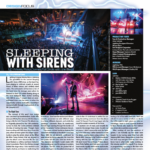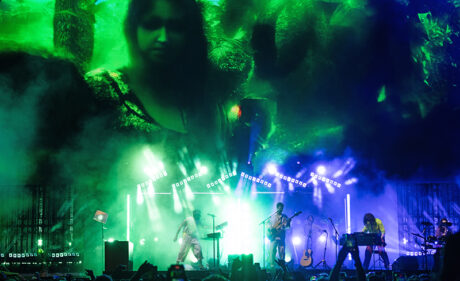
When acclaimed indie rock band MGMT decided to revisit their 2007 major label debut, Oracular Spectacular, they envisioned a reinvention of it, with a theatrical presentation that relied on an especially creative production design. The one-off show of their biggest hit album happened May 13, 2023, at the Just Like Heaven Festival at the Brookside venue at the Rose Bowl in Pasadena, CA.
An artist revisiting a hit album and playing it live note-for-note is fairly common these days.
This wasn’t that. It was imaginative, inventive, and chock full of new gear. Show Direction, Production Design, and Lighting Design was handled by Ricardo Rojas of Ricardo Rojas Design, Inc., and in speaking with him about it, it is clear that a lot of fun was had.
MGMT was founded by multi-instrumentalist Ben Goldwasser and Andrew VanWyngarden in a college dorm in 2006, and Rojas first worked with them in 2018 for their Little Dark Age World Tour. “I was programmer/lighting director and made some of my best friends in the industry on that tour,” he says. Then came the call for this MGMT show. “They asked me to do production and lighting design, and I felt that I had ‘graduated’ a little bit,” he says with a laugh. “It was meaningful that they trusted me.”
Rojas was in college when Oracular Spectacular was released. He was one of many that immediately loved it. For his production design for the re-envisioning of the album, he explains, “They had this vision of doing it like a high school play. There were interludes with dialog, and a nod to their fun and quirky beginnings”—which included playing hockey on the stage. Goldwasser and VanWyngarden approached it with more of a script than a setlist, saw it as more of a theatrical production than a concert, and wanted to both celebrate and even poke a little fun at their earlier selves. “They came to me with a general creative direction that I then helped execute.” Influenced by Talking Heads’ Stop Making Sense tour from 1983, early in discussions there was a desire to see stagehands build and then break down the set. “We just started throwing around ideas, and then Production Manager Jonathan Nelson and I sat down and talked through it.”
Rojas says early on he envisioned a modular stage and then came up with the idea of a blow-through video screen that had two parts so it could open in the middle. “The idea was to have this video element behind the band but to be able to mess with it, so it sometimes opens to reveal other scenic elements; but it also opens just half way on other songs for an asymmetrical look. It really helped build the narrative and tell the story.” The video screen was made of 20 ROE Carbon CB8 Transparent panels supplied by Fuse Technical Group.
“A challenge was figuring out where we were going to put it all,” he says. It was a lot: MGMT was performing with Goldwasser and VanWyngarden as the focal point, plus a children’s choir of 12; guest drummer and keyboardist; two guest vocalists; and a team of six dancers. The visible stage crew were put in referee outfits, seen as they moved it all on and off the stage according to the song. Goldwasser and VanWyngarden also wanted a B-stage that they could perform on. Nelson had suggested using a cube truss structure, which Rojas thought was a great approach, and expanded the design. The structure and staging was from All Access Staging and Productions.
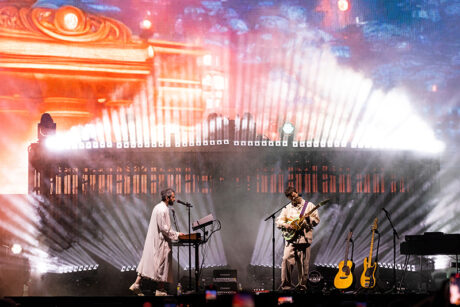
New Tools, Something Fresh
The vendor for all lighting and haze was Burbank-based Volt Lites. “They are great partners and provided me with a lot of new lights on this project,” Rojas says. “There are a lot of important details put into the design of this show, and Volt did a great job executing it.” Some of those new lights included Claypaky Volero Wave fixtures as well as MAC AURA XIPs and ACME Pixel Line IPs. Added to that was the Claypaky Panify, a crucial element because it allows the designer to take a static fixture and pan it for a vibrant effect. “That Panify is something that really lent itself to telling a story and creating different moods. It was great because it allowed us to get these really cool angles, and I liked using it with the Waves because it gave me that architectural look which I knew I wanted.” Rojas put two rows of them behind the band, one at the bottom of the structure and one at the top. “I was driven to provide something fresh, and that combination provided something that is different than anything out there.”
He also notes that the MAC AURA XIP has a “beautiful flower-like filament” and made for a theatrically gorgeous look. There were 12 Aura XIPs on the upstage pre-rigged truss, 4 on top of the cube structure, and 2 behind Goldwasser and VanWyngarden, which were used as backlights. At key moments these were used to create an aura-like visual effect. Then he used the ACME Pixel Line to dress the set. “It is an LED bar that is cool and flexible.” The design also included the Ayrton Diablo, which Rojas says is a great spot.
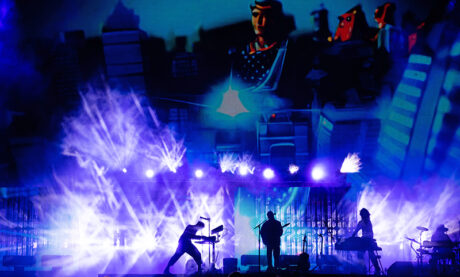
A good example of how dynamically Rojas used the design elements was for the song “Electric Feel”—the video wall opens as the Panify moves the Waves. It went from one seemingly seamless horizontal line to six sets of eight Waves that were suddenly vertical. “This was a big reveal, and seeing this new lighting element while the video elements move offstage was effective. There was a lot of thought that went into the programming of that moment that built up to a climax. Another strong moment was during the song “4th Dimensional Transition.” Rojas describes, “We made a gag of it. When the previous song ended, we blinded the audience with the lights on the floor and with the Ayrton Diablos which were on top of the cube structure, and then Ben and Andrew ‘disappeared’ for a moment, suddenly showing up on the B-stage.” For the song he then turned out the mid-stage lights and featured the Waves on the floor, shooting up, providing that desired “rave” vibe. Half the video wall featured a skeleton, the other half was taken away, and with the Waves creating a green aurora-like look, it was an extremely vibrant moment.
Rojas is aware that it was a bit daring to use so many new lighting products on a high-profile one-off, noting “There’s always a little concern when exploring newer technology, but I took the lead from the band. They were taking risks, and I wanted to match that energy and push the production in a different creative direction then they have had before…but I did do my research on it all.” He adds that since he has a great relationship with Volt and trusts them completely, he felt that anything coming out of their warehouse was going to be show-worthy. And yet it’s all for a one-off—or is it? “It did go very well, but they will neither confirm nor deny doing more shows,” he comments. “I think people are asking to see it, so I don’t know if this is the last we’ve seen of this design. That’s all I can say right now!”
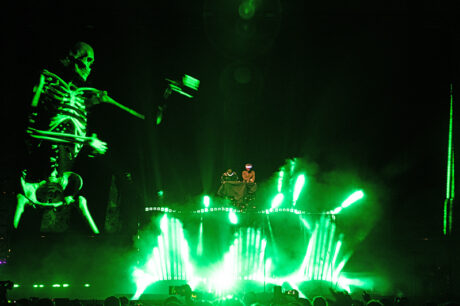
Production Team
- Tour Manager: Craig McQuiston
- Production Manager: Jonathan Nelson
- Stage Manager: Savannah Kurtz
- Creative Direction: Ben Goldwasser, Andrew VanWyngarden, and Tom Scharpling
- Show Direction / Production Design / Lighting Design: Ricardo Rojas Designs, Inc.
- Lighting Programming: Danni Cabaruvias
- Lighting Crew Chief: James Eyers
- Lighting Technician: Axl Barsch
- Playback: Steve Nalepa
- Content Design/ Content Direction: 2n Studio
Vendors
- Lighting Vendor: Volt Lites/Matt Shimamoto
- Video Vendor: Fuse Technical Group
- Staging Vendor: All Access Staging
Gear
- 12 Claypaky Volero Wave
- 12 Claypaky Panify
- 18 Martin MAC Aura XIP
- 18 Ayrton Diablo
- 11 ACME Pixel Line IP
- 8 Portman Hexaline
- 6 Astera Titan Tube
- 12 CHAUVET COLORado 1QS
- 3 Master FX Mystic Hazer
- 6 8’ Tyler Truss PRT black
- 1 MA Lighting grandMA3 full-size
- 1 MA Lighting grandMA3 NPU
